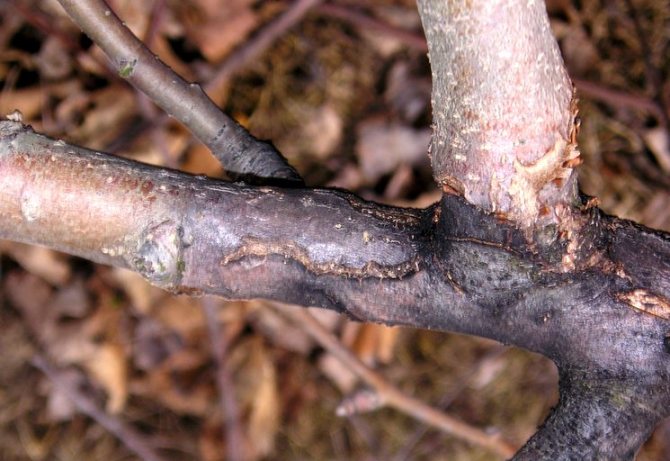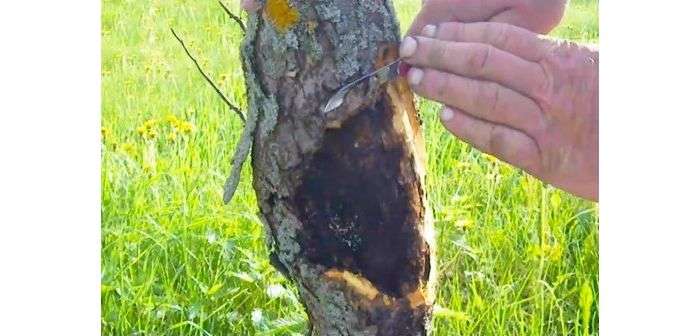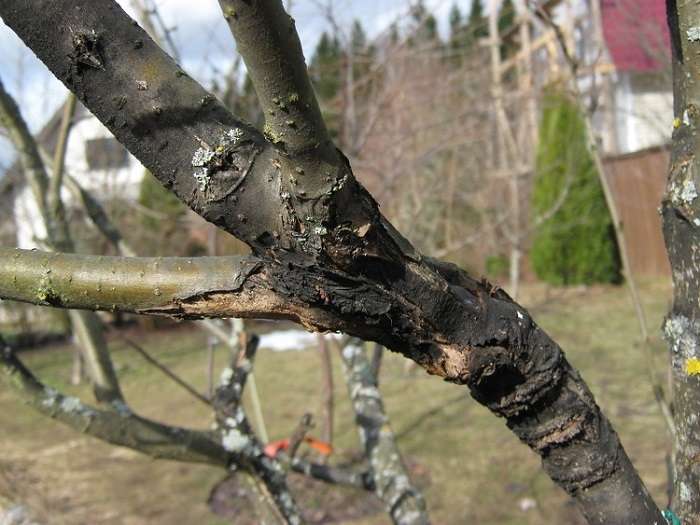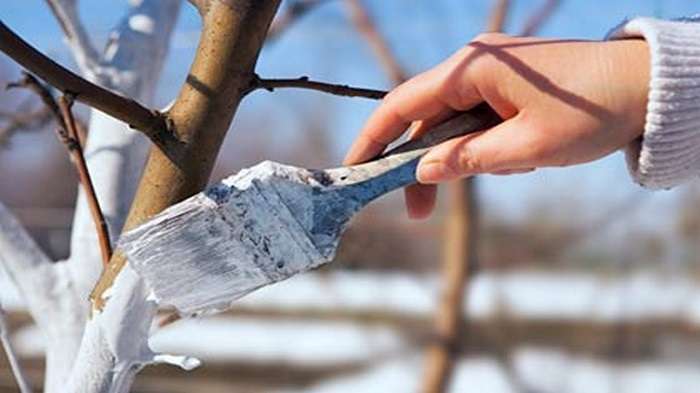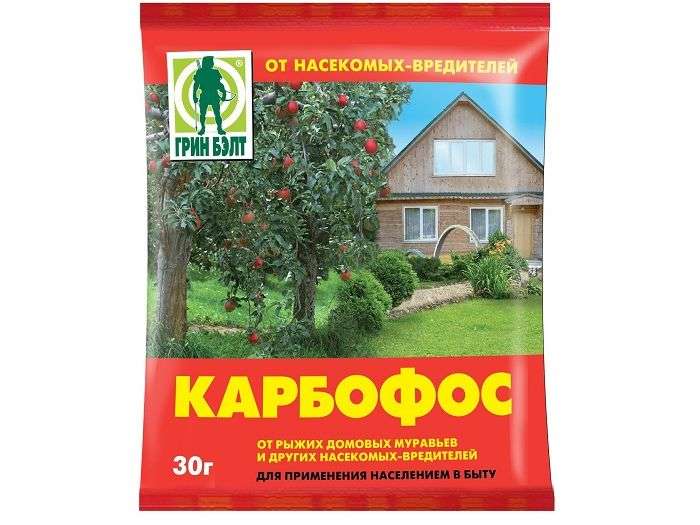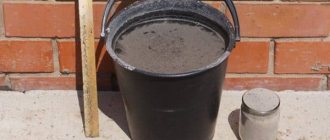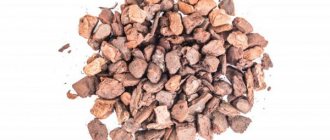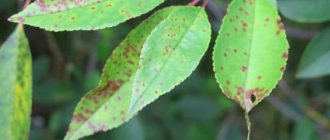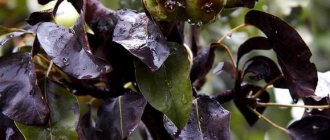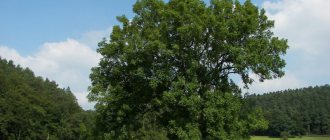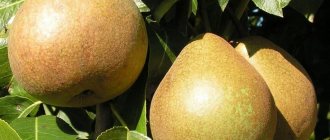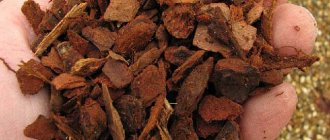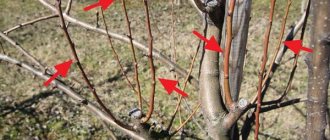Cracks on apple trees should alert the gardener! If you do not start fighting with them in time, then not only the harvest may decrease, but the whole tree may also die.
The disease can spread to other fruit trees and in a short time affect almost the entire garden, causing it serious damage.
In this article, you will learn why the bark of apple trees bursts and how to prevent cracks in the trunk of your tree and what to do with them if they have already appeared.
If the bark cracks and ...
Gets wet
The reasons for the wet and cracking of the bark of an apple tree can be different.
The most common cause may be wrong pruning of wood, poor-quality treatment and disinfection of wounds.
Rotting wood can begin due to the ingress of water, microbes, viruses or fungi from the air into the cut site.
Turns black
If the trunk of an apple tree cracks and at the same time turns black, then this means that the tree has fallen ill with the most terrible disease, called black cancer.
The bark of the tree peels off and falls off, exposing the black wood.
The disease spreads to branches, crown.
The disease destroys the tree within 3-4 years. If the disease is not detected at the very beginning of development, then it will no longer be possible to save the tree.
Peels off
Cracks and exfoliation the crust can be caused by a number of reasons. For example, due to sudden changes in day and night temperatures, the bark of a tree loses its elasticity and longitudinal cracks appear.
And severe frosts, sunburn or fungal diseases can lead to more dangerous transverse crackingthat can lead to the death of the tree.
The bark bursts and the fruits dry
If the bark on an apple tree bursts, then due to a lack of nutrients the fruits can dry on it, since in case of significant damage to the bark, nutrients from the soil do not reach the fruits.
Such wounds can appear on a tree as a result poor quality trimming, as well as freezing under severe winter conditions in weakly winter-hardy varieties.
Yellow lichen and peeling bark
The older the apple tree, the greater the risk of formation on the bark. lichen.
As a rule, it appears on the trunk and branches at high humidity and low temperatures.
The lichen is white to yellow in color and spreads very quickly.
If you do not delete it, then on the tree may appear fungal diseasesthat lead to the decomposition of the bark.
Major bacterial diseases of trees
The bacteria can also parasitize fruit trees. Infection occurs through damage in the bark, including when the pruning technology is violated.
Bacterial burn
Diseases of cacti: common diseases and their treatment methods
You can recognize an ailment with this name by protruding drops of liquid with an unpleasant odor that is released as a result of the disease. Flowers are the first to undergo disease, then the turn of leaves comes. If the plant is left untreated, the burn covers the young shoots and bark, on which a distinct maroon marble pattern appears.
Important! To save a tree from a bacterial infection, action must be taken immediately.
In August
In August, after a dry summer, the rainy season begins, which causes young apple trees rapid growth of wood.
This is the reason why the bark of the apple tree cracks.
The bark of the tree lacks elasticity, it does not hold up and cracks along the trunk. Such wounds are not terrible for a tree; they should be washed with a 3-5% solution. ferrous sulfate, and whitewash the tree trunk with the addition of 100-300 ml of copper sulfate per 10 liters of solution.
Why did the plum trunk crack?
The stem of the plum is rather weak and fragile. If the tree is grown without proper pruning, it will lead to the appearance of longitudinal cracks on the stem surface. Sometimes the plant even breaks in two.
If longitudinal cracks are found, act as soon as possible.
The first step is to connect the drain into one piece, and then protect the gap with a wire bandage clamp. Then the wire must be twisted like a "harness overlay".
The crevice must be covered with copper sulfate and wrapped with gauze.
It is worth removing the mixture and bandages in the spring. The wounds are washed and treated with garden varnish.
In the spring
Cracking of the bark of apple trees often occurs in early spring, it is associated with sharp fluctuations in air temperature.
On clear sunny days, the bark of trees is very hot. Sunburn occurs, tissue structure is disrupted.
As a result of such damage, whole areas of the cortex can die..
Such phenomena can occur in apple trees that grow too wet soil or very deeply set. And also if the type of tree is weakly winter-resistant.
Insects and fungi
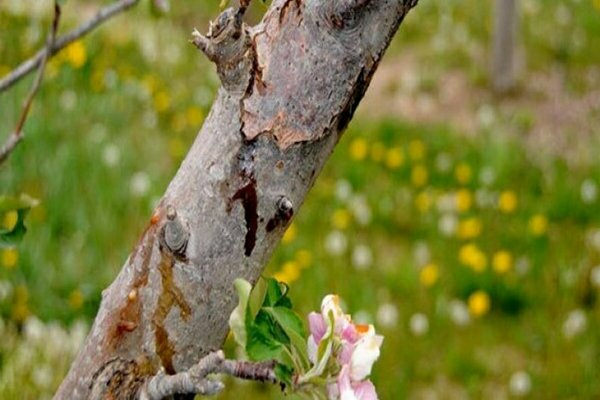
The peeling of the cover can be provoked by a bark beetle eating it. In addition, many insect pests hibernate in cracks or lay their eggs there, causing new sections of the bark to burst.
Often, the bark of a pear leaves due to infection with a fungus: once it gets into a small wound, the infection begins to eat away at the tissue. Because of this, the trunk is covered with black dots. When a fungal infection is neglected, the cover peels off and even peels off in pieces.
The bark of the apple tree is cracking - what to do?
Apple tree care
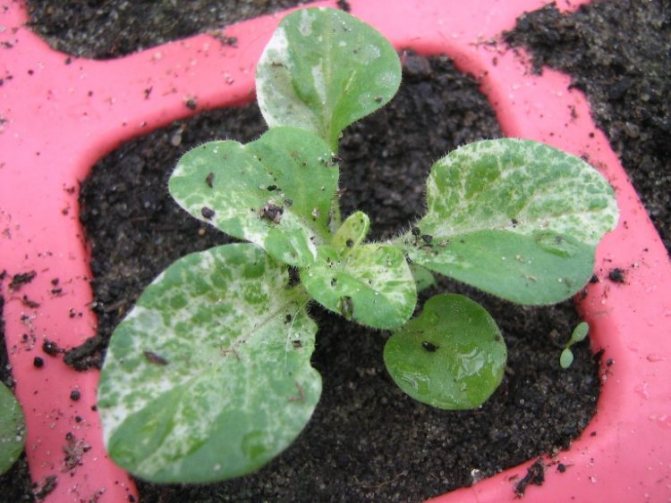

Frost cracks in the bark.
The reasons for the peeling of the bark on an apple tree are different. If there are few wounds, the tree itself can cope and continue to bear fruit.
But if such damage is significant, then it can lead to tree death... In such cases, it is necessary to carry out a number of measures aimed at saving the apple tree.
Damaged spots should clean up disinfected tool.
This should be done carefully, without touching the healthy bark.
After stripping, they must be rinsed with a solution. potassium permanganate, brilliant green or hydrogen peroxide... After drying, cover it with garden pitch, wrap it well with black polyethylene, you can tie it with burlap or any unnecessary cloth in several layers in order to exclude infection.
As a result of this treatment, the wounds will heal, the healing process will begin and the incision will heal. The scraped-off pieces of bark should be delete from the site.
TIP! Having completed urgent procedures for saving apple trees, it is advisable to treat the entire garden with a 3% Bordeaux mixture, which will protect it from many diseases.
Do I need to replant apple trees?
In practice, bark cracking is most often seen in older apple trees. Wherein a damaged tree with trunk bark disease should not be replanted, since transplanting an adult tree is always a very laborious process.
And the survival rate in a new place for diseased trees is very low, and your work will become useless.
Patients withit is better not to touch old trees at all, there is a high probability that they will die.
It is best to replace them with new seedlings, but if your old apple tree is very dear to you, then, depending on the degree of the disease, you can try to save it.
TIP! For example, if the bark is cracked around a branch, then it should be completely removed. So you can eliminate the infectious focus, encourage the tree to grow and thus create a rejuvenating effect.
How to save an old apple tree?
Trees, like humans, tend to age. Over the years, they also start to get sick. One of these diseases, typical for old plants, is cracking and flaking of the bark.
Depending on the degree of the disease, a number of simple operations can be performed to rescue a beloved tree.
- If the disease affects small areas, then with the help metal brush, pre-disinfected, all loose bark must be carefully removed.
- With it, you will remove all kinds of pests.
- After which it is necessary whitewash all cleaned areas, as well as other trunks and branches for the prevention of fungal diseases and sun exposure. You can add to lime mullein, this will strengthen the plant.
TIP! If the damage has affected significant areas, then diseased branches can be cut, and the cuts must be treated with garden varnish in order to protect against insects and other pests, as well as fungal and infectious diseases.
Clay treatment of tree bark. Cooking a clay talker for seedlings


The "miraculous" properties of the clay talker are well known to every experienced owner of a summer cottage or personal plot. It is widely used by gardeners for the protection and treatment of fruit trees, since it has powerful antiseptic properties and well protects the roots of seedlings from drying out during transportation.
In addition to its high efficiency, the main advantages of the clay chatter are also minimal costs and ease of preparation. At the same time, it has high plasticity, good water resistance, effectively destroys pathogens, protects plants from the adverse effects of the sun, wind and cold, helps to heal wounds in case of mechanical damage to the root system and bark.
Usually, clay talker is used to increase the survival rate of seedlings when planting, but its properties are also widely known as a means of increasing the shelf life of vegetables and flowers, it is also used as a whitewash and garden putty.
That is why, despite the abundance of modern care products for fruit trees, the clay talker has not lost its relevance for many years and its popularity among gardeners is still high.
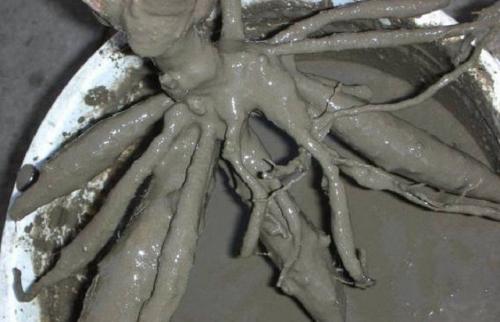

Protection of the root system of plants during transportation
Usually, a clay talker is used to protect the roots of seedlings during transportation or short-term (up to one week) storage.
For this purpose, the roots of seedlings of fruit trees and shrubs are dipped into a thick mixture of clay, water, sawdust or straw. This solution acts as a protection for the root system of plants, while contributing to the retention of moisture.
The roots of seedlings are sometimes additionally packed in a plastic bag or tightly wrapped in burlap.
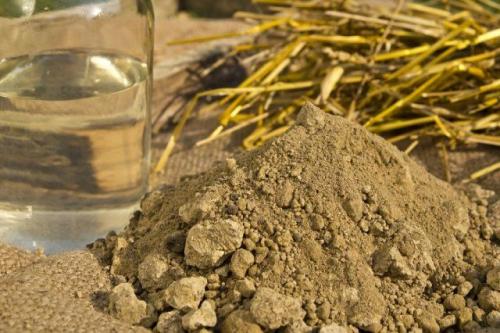

To prepare a clay talker, 10 liters of water are usually taken, to which a small amount of clay is added, as well as about 1 kilogram of rotted manure. Many gardeners add plant growth stimulants to the ready-made mixture.
Clay cover is usually rinsed off immediately before planting in a permanent place to free the roots to absorb moisture and nutrients.
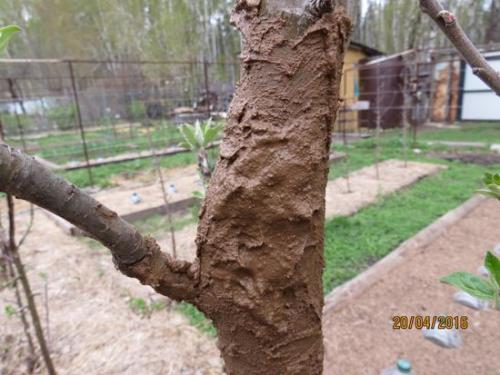

How to deal with bark beetle?
One of the common hazards for cultivated plants is insects - pests.


Pests of the apple orchard.
The most problematic of these are insects that live under the bark of trees. These include beetles - bark beetles, which not only weaken the tree, but can completely destroy it.
At the same time, they attack to a greater extent on weakened plants that have cracks, burns, wounds... It is very difficult to deal with them, since they live inside the wood. The methods of dealing with the bark beetle depend on the degree of damage to the tree.
If the bark exfoliates on an apple tree in many places and insect moves are found there, while there are clear signs of the tree's wilting, then most likely it can no longer be saved.
You need it cut down, uproot the stump and remove from the site.
ATTENTION... In this case, weak trees should be carefully considered, since bark beetles can use them for new nests, they may also need to be removed.
If one or two holes with small sawdust are found on the tree and the tree looks healthy, then you need to take measures to get rid of insects.
In the detected holes, a syringe is introduced several times with a means for the destruction of garden pests.
These drugs are:
- "Antizhuk",
- "Calypso",
- "Antishashelin»
- and others.
After the medicine is absorbed, the passages must be treated with garden varnish.
Diseases of fruit trees
Diseases of trees are associated with many disorders. All ailments of horticultural fruit crops can be conditionally divided into 2 groups:
- the source of which is fungi;
- caused by exposure to bacteria.
For your information! Penetrating into woody tissues, pathogens begin to destroy them and ultimately destroy them completely. The choice of the method of struggle depends on the correct recognition of the pathology.


Fruit trees are the decoration of any garden
Whitewashing apple trees as a measure of control
When the bark of an apple tree cracks - what to do if it happens to old apple trees.
The complex of measures to combat these diseases includes whitewash.
This simple procedure consists of the following rules:
- Under the crown of the tree, you need to spread a film or fabric.
- With a special tool, gently clear obsolete bark.
- Stripping places smear over garden pitch.
- Start whitewashing the cleaned areas and the tree trunk with lime.
- All cleanings must be collected and removed from the site or burn.
If there are problems with the bark?
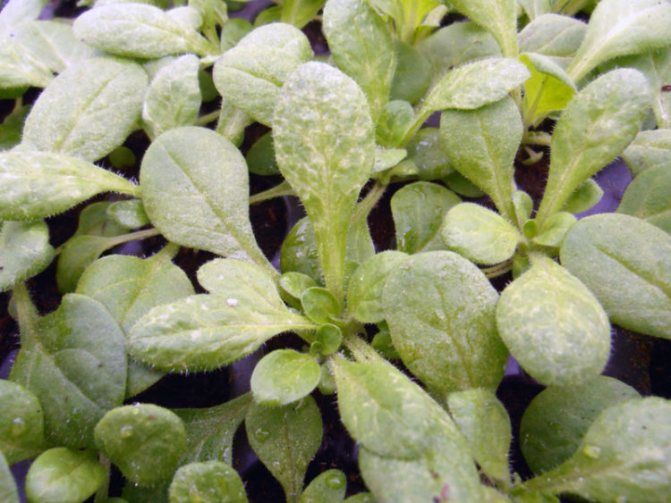

Whitewashing the apple tree.
At a young apple tree
Young apple trees can suffer from various attenuating factors. Cracks formed cause infections.
To combat them, you must:
- Cut cracks to healthy parts (up to 2 cm deep);
- Spill them iron (3-5%) or copper sulfate (2%);
- Lubricate with special grease.
- Whitewash the trunk;
- Remove all debris from the site.
- Before winter it is desirable dig up ground around the trunk.
ADVICE. Before spring blooming, you can feed the tree with a fertilizer containing boron and magnesium.
At the sapling
Those apple tree seedlings that grow too much are prone to cracking in the bark. wet soil, deeply planted or overfed with fertilizers, as well as low-winter-resistant varieties.
In addition to these factors, it must also be added that during the period of active growth trunk of young trees thickens, the bark on young trees stretches and bursts.
In this case, you can use a sharp knife along the trunk from the bottom to the top to carry longitudinal bark incisions... It will come apart by 1-2 mm, but soon the incisions will be overgrown.
Prevention of cracks
A strong, well-groomed apple tree is less likely to suffer from cracks in the bark. Compliance with the standard requirements of agricultural technology protects the garden from these negative phenomena.
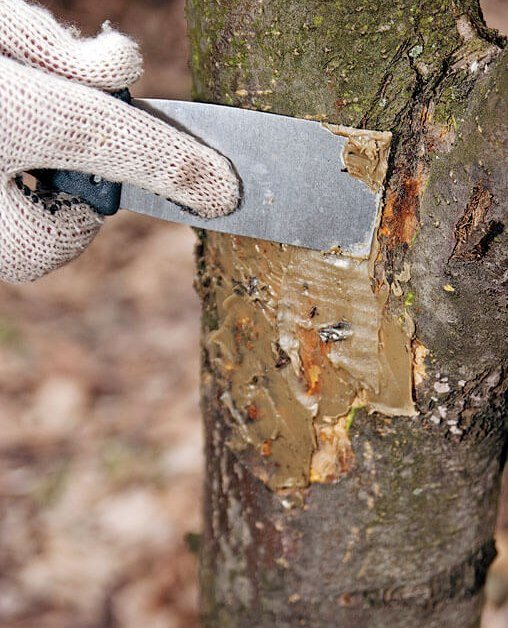

Cracks are easier to deal with at the very beginning of their appearance.
- Garden location - sunny, without close standing groundwater and spring flooding.
- Planting without burying the root collar.
- Regular inspection of trees.
- Whitewashing of trunks and skeletal branches - in autumn, if necessary - with an update in early spring. This is a very important measure in the prevention of burns and frost damage. Sometimes, instead of whitewashing, the trunks are tied with white paper in 2 - 3 layers for the winter.
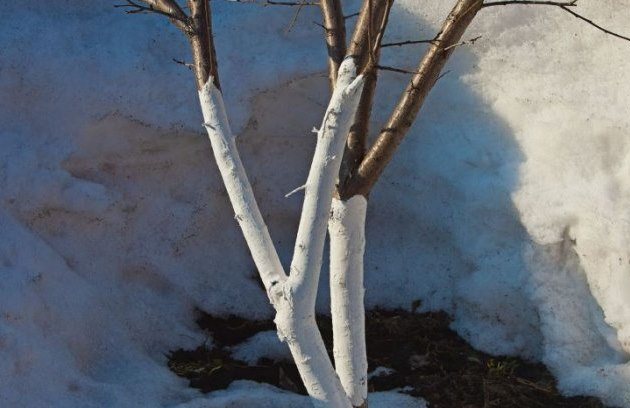

Whitewashing will prevent apple tree trunks from cracking in early spring. - Timely sanitary pruning - the careful removal of diseased and broken branches, with their further burning or deep composting. Treatment of any wounds and their protection from the penetration of infections. Disinfection of the instrument.
- Top dressing - complex fertilizers with microelements: in spring - with a predominance of nitrogen, closer to autumn - with phosphorus and potassium.
- Spraying against diseases and pests.
- Sub-winter water-charging irrigation, increasing winter hardiness (carried out before the soil freezes: at least 50 liters for a young tree and at least 200 liters for an adult apple tree).
The selection of hardy varieties - zoned, on reliable rootstocks - significantly reduces the number of problem situations. Planting material for laying a garden must be healthy, from reliable producers. The same rule applies to the acquisition of cuttings for grafting.
The bark of a young apple tree cracks at the base
A young apple tree mainly has august the bark may crack at the base. So why is the trunk of the apple tree cracking?
This is due to the fact that after a dry summer, the heavy rainy season begins, the wood of a young the tree begins to grow rapidly, and the bark has already completed its seasonal growth and lacks elasticity.
IMPORTANT! This phenomenon poses a danger to the wintering of the tree. The bark is cracking on the apple tree, what to do is a serious question for the gardener.
After all, if you dig the base of the trunk with earth, then it will underpin, which will lead to spring detachment.
If you do not do this, then the exposed parts of the wood can freeze.
In this case, in the fall it is necessary smear over places of exfoliation with garden pitch, and in winter it is necessary spud snow.
Clay tree putty. How to cover up a cut on an apple tree?


After the cleaned and disinfected cut on the apple tree dries up, it must be covered with a special tool. This is done to seal damage to close the entrance to pests, bacteria and fungi.
In addition, in the place of an unprotected cut, the branch may begin to dry out. This is due to the fact that:
- Sap flow is impaired, nutrients do not flow to that part of the branch that is located above the damage;
- Moisture evaporates through the wound.
An unprotected wound is prone to cracking, sometimes cracks are deep. A hollow may form in the place where the saw cut damaged the bark of the apple tree.
Used as a putty:
- Garden var;
- A thick talker made of clay and mullein;
- Oil paints on natural drying oil;
- Cement mortar - for particularly large damage;
- Water-based paints;
- Artificial bark (balm - varnish).
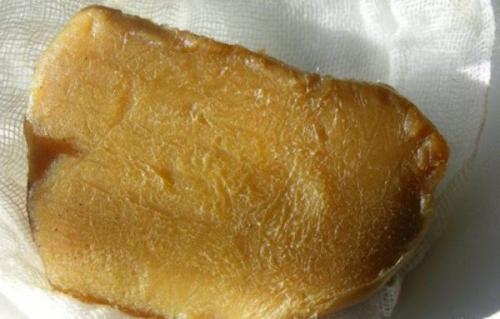

Garden var.
Garden var can be purchased at the store, or you can cook it yourself. For its preparation, wax, rosin and fat are used.
The wax does not allow water to flow to the wood, does not allow the putty to drain from the wound. The stickiness of the rosin allows the var to bond firmly to the wood. The grease prevents the putty from cracking in any weather.
Any unsalted fat is suitable. You can replace it with vegetable oil or natural linseed oil. Turpentine is suitable instead of wax.
- Take 1 part rosin and fat, and 2 parts wax. The rosin, wax and fat are melted separately and then mixed. This solution is slowly poured into cold water. Take out after hardening;
- Mix also 20 parts of paraffin, 4 parts of rosin and 1 part of drying oil;
- Rosin and wax in 2 parts, vegetable oil - 1;
- Rosin 1.5 parts, oil - 2. Heat, mix and pour in 1 part of turpentine. It is important to do this away from fire.
Ash can be added to the garden pitch.
IMPORTANT! The garden pitch is slightly warmed up before application to soften it. It is applied in a very thin layer so that it looks like a thin film is applied to the cut.
If you cover the cuts on apple trees with a thick layer of garden varnish, the wood under it will begin to rot after a while.
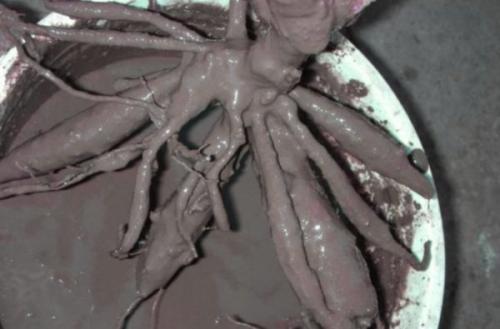

Clay talker.
Clay talker: To make putty from clay, take 2 parts of clay, 1 part of mullein, a little chopped straw or hay. Stir and dilute with water until the consistency of sour cream.
Cement mortar: 1 part of cement, 3 parts of fine sand is mixed with water and a little drying oil is added. Suitable for filling deep wounds and cracks.
Oil and water-based paints are washed off after a while by the rain and will have to be renewed.



